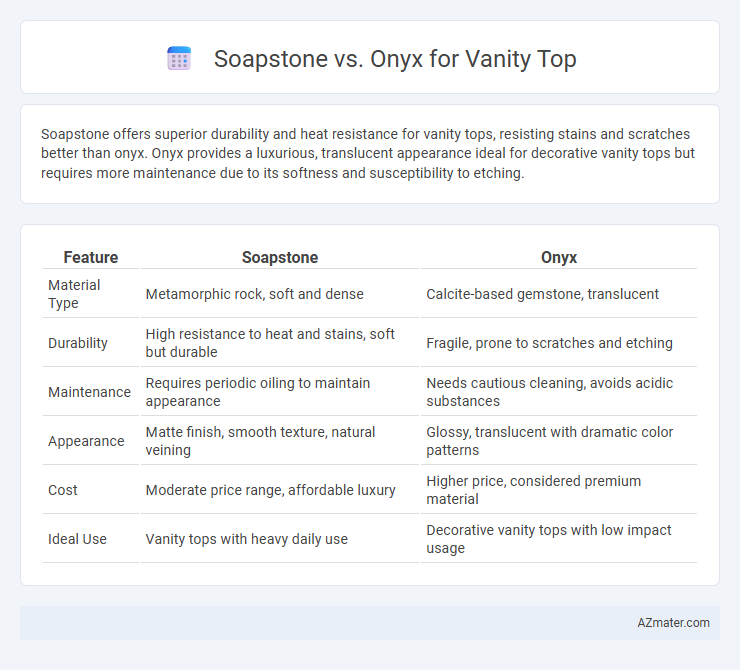Soapstone offers superior durability and heat resistance for vanity tops, resisting stains and scratches better than onyx. Onyx provides a luxurious, translucent appearance ideal for decorative vanity tops but requires more maintenance due to its softness and susceptibility to etching.
Table of Comparison
| Feature | Soapstone | Onyx |
|---|---|---|
| Material Type | Metamorphic rock, soft and dense | Calcite-based gemstone, translucent |
| Durability | High resistance to heat and stains, soft but durable | Fragile, prone to scratches and etching |
| Maintenance | Requires periodic oiling to maintain appearance | Needs cautious cleaning, avoids acidic substances |
| Appearance | Matte finish, smooth texture, natural veining | Glossy, translucent with dramatic color patterns |
| Cost | Moderate price range, affordable luxury | Higher price, considered premium material |
| Ideal Use | Vanity tops with heavy daily use | Decorative vanity tops with low impact usage |
Introduction to Soapstone and Onyx Vanity Tops
Soapstone vanity tops are prized for their durability, heat resistance, and natural, smooth matte finish that darkens over time, making them a timeless choice for bathrooms. Onyx vanity tops stand out with their translucent properties and striking veining patterns, providing a luxurious and elegant appearance that can dramatically enhance any bathroom design. Both materials require regular maintenance to preserve their beauty, with soapstone being more resilient to staining and onyx needing careful sealing to prevent damage.
Unique Characteristics of Soapstone
Soapstone offers unparalleled heat resistance and natural stain repellency, making it ideal for vanity tops in busy bathrooms. Its smooth, matte surface develops a unique patina over time due to its high talc content, enhancing its natural beauty and durability. Unlike onyx, soapstone is non-porous and requires minimal sealing, providing a low-maintenance yet elegant option for vanity surfaces.
Distinctive Features of Onyx
Onyx vanity tops are prized for their striking translucency and vibrant veining, creating a luxurious aesthetic unmatched by soapstone. Unlike the matte, earthy appearance of soapstone, onyx offers a glossy finish that can be backlit to highlight its natural patterns, adding depth and elegance to bathroom designs. Its softer composition requires careful maintenance but provides a unique visual appeal through its delicate layers and color variations.
Durability Comparison: Soapstone vs Onyx
Soapstone offers superior durability for vanity tops due to its resistance to heat, stains, and scratches, making it less prone to damage over time compared to onyx. Onyx, while visually stunning with its translucence and unique veining, is softer and more susceptible to scratching, etching, and moisture damage, requiring careful maintenance. Choosing soapstone ensures a long-lasting, low-maintenance surface ideal for bathroom environments, whereas onyx demands gentle care to preserve its aesthetic appeal.
Maintenance Requirements for Each Material
Soapstone requires minimal maintenance, needing only occasional seasoning with mineral oil to maintain its dark luster and prevent drying. Onyx, being a softer and more porous stone, demands regular sealing and careful cleaning with pH-neutral products to avoid etching and staining. Soapstone's durability and resistance to heat make it easier to upkeep in a busy vanity setting, while onyx's delicate nature requires more diligent care to preserve its glossy appearance.
Aesthetic Appeal: Color and Pattern Variations
Soapstone offers a rich, matte finish with deep charcoal to dark gray hues, often accented by soft veining that imparts a timeless, natural elegance to vanity tops. Onyx stands out with its striking translucency and dramatic color range, from creamy whites and warm ambers to vivid greens and reds, creating a visually captivating, luxurious statement piece. The unique patterns in onyx, often resembling flowing waves or crystalline structures, contrast with soapstone's more subtle, earthy marbling, making onyx a bolder choice for a vanity top's aesthetic appeal.
Cost Analysis: Soapstone vs Onyx Vanity Tops
Soapstone vanity tops generally cost between $70 to $120 per square foot, making them a more affordable option compared to onyx, which ranges from $100 to $250 per square foot due to its rarity and distinctive veining. Installation expenses for both materials vary, with onyx often requiring specialized labor that increases overall project costs. Long-term maintenance costs favor soapstone as it resists stains and scratches naturally, whereas onyx demands careful sealing and upkeep to preserve its delicate surface.
Installation Considerations and Challenges
Soapstone offers easier installation for vanity tops due to its softer composition, allowing for simpler cutting and shaping compared to onyx. Onyx's brittle and translucent properties require careful handling and professional expertise to avoid cracks or breaks during installation. Proper sealing and support structures are essential for both materials, but onyx demands more precise environmental control to prevent damage from moisture and UV exposure.
Suitability for Bathroom Environments
Soapstone is highly suitable for bathroom vanity tops due to its non-porous nature, resistance to moisture, and low maintenance requirements, making it durable against humidity and frequent water exposure. Onyx, while visually striking with its translucency and unique veining, is more porous and softer, requiring regular sealing and careful maintenance to prevent staining and etching in wet bathroom environments. Soapstone's heat resistance and chemical inertness provide practical benefits, whereas Onyx's delicate surface demands cautious use to preserve its aesthetic appeal in a bathroom setting.
Final Verdict: Choosing the Best Vanity Top Material
Soapstone offers exceptional durability, resistance to heat and stains, and a natural matte finish that ages beautifully, making it ideal for high-traffic bathroom vanity tops. Onyx provides a striking, translucent appearance with unique veining patterns, but its softness and higher maintenance requirements make it less practical for everyday use. For a balance of longevity and ease of maintenance, soapstone generally ranks as the superior choice for vanity tops, while onyx suits those prioritizing aesthetic appeal over durability.

Infographic: Soapstone vs Onyx for Vanity Top
 azmater.com
azmater.com